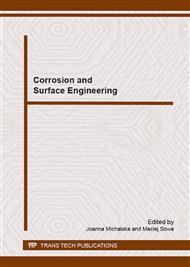p.75
p.79
p.83
p.87
p.91
p.95
p.99
p.103
p.107
Corrosion of WE43 and AE44 Magnesium Alloys in Sodium Sulfate Solution
Abstract:
Magnesium alloys have low density densities and high specific strengths that are comparable to steels and titanium alloys. Therefore, they are widely used as structural materials in the automotive and aerospace industries. However, the use of magnesium alloys is hindered by the fact that they offer insufficient resistance against corrosion, even in diluted electrolyte solutions. We examined alloys from the Mg-Y-RE-Zr and Mg-Al-RE systems (WE43 and AE44) that are used in the domestic and international automotive and aerospace industries. In these applications, the alloys are exposed to corrosion in environments containing electrolytes. It is commonly known that hydrogen is the main corrosive factor, appearing during chemical reactions between magnesium and water in an electrolyte solution. Selecting rare earth-containing magnesium alloys allows us to analyse the various effects of hydrogen on these materials. Hydrogen interacts with the selected alloys in a manner that depends strongly on alloy structure and chemical composition—these factors cause variations in the concentration, solubility, and diffusion rate of hydrogen in the host material. After hydrogen uptake, the cracking velocity of each alloy phase is different and is related to cracking micromechanisms. Our results show that when samples were immersed in 0.1M sodium sulfate solution, hydrogen atoms diffused into the material and enriched the intermetallic phases. With increased immersion time, magnesium hydride fractures in a brittle manner when the inner stress caused by hydrogen pressure and the expansion stress due to the formation of magnesium hydride are higher than the fracture strength.
Info:
Periodical:
Pages:
91-94
Citation:
Online since:
January 2015
Authors:
Keywords:
Price:
Сopyright:
© 2015 Trans Tech Publications Ltd. All Rights Reserved
Share:
Citation:


